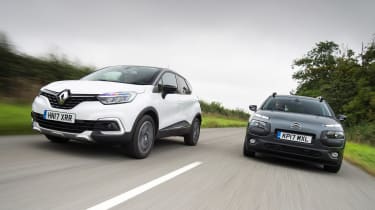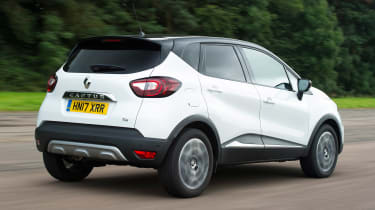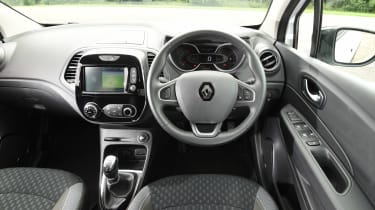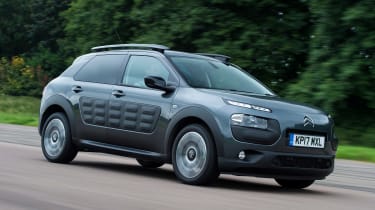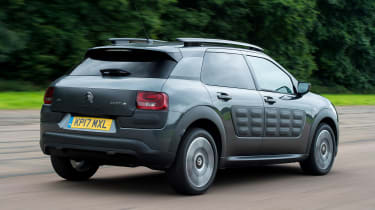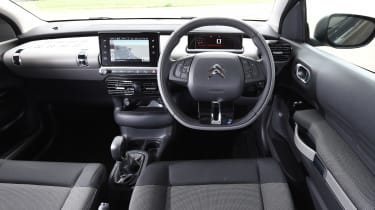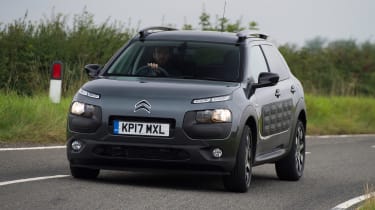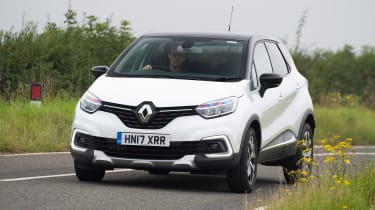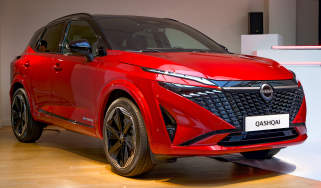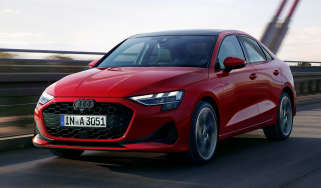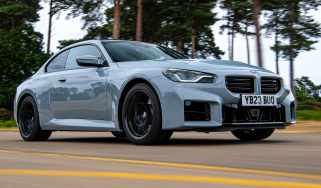Renault Captur vs Citroen C4 Cactus
Does the revised Renault Captur have what it takes to steal small SUV crown from the Citroen C4 Cactus?
Renault’s Captur was the best-selling supermini-based SUV in Europe in 2016, but with the new Koleos large SUV joining the Kadjar in the company’s range, the French brand has implemented a light mid-life facelift for its compact crossover.
A new look, more kit and better safety tech are the key points with this new Captur, but is that enough for it to beat our favourite small SUV, the Citroen C4 Cactus?
• Best crossovers and small SUVs
Here we’re testing petrol-powered versions of both cars. These 1.2-litre turbo units will have plenty of performance and economy for most people, and could be cheaper to run than a diesel version.
We’ve brought them together to see if the Captur deserves its high-selling status, and if it can beat its fellow French SUV.
Head-to-head
| Model: | Renault Captur 1.2 TCe Dynamique S Nav | Citroen C4 Cactus PureTech 110 Flair Edition |
| Price: | £19,355 | £19,825 |
| Engine: | 1.2-litre four-cylinder petrol turbo | 1.2-litre three-cylinder petrol turbo |
| Power/torque: | 118bhp/205Nm | 108bhp/205Nm |
| Transmission: | Six-speed manual, front-wheel drive | Five-speed manual, front-wheel drive |
| 0-60mph: | 10.6 seconds | 10.8 seconds |
| Top speed: | 113mph | 117mph |
| Test economy: | 38.8mpg | 45.8mpg |
| CO2/tax: | 125g/km/£140 | 100g/km/£140 |
Renault Captur
- • For: Stylish looks, smooth engine, plenty of equipment as standard.
- • Against: Dated interior, occasionally unsettled ride, dull to drive.
Renault has kept things simple with this facelifted Captur, so while there’s a new look and more kit, under the skin it’s not that different to the company’s original Clio-based SUV.
That means it’s sharper to drive than the Cactus, with faster steering, a more precise gearshift and better body control through corners. However, it’s stiffer than the Citroen, too, and while the car is pretty comfortable on most roads, significant imperfections in the surface tend to upset the Renault more than its rival, particularly when the chassis is already loaded up through a corner.
More reviews
Car group tests
- Honda HR-V vs Renault Captur vs SEAT Arona: 2021 group test review
- Hyundai Bayon vs Citroen C3 Aircross vs Renault Captur
In-depth reviews
Long-term tests
Road tests
Used car tests
While the Captur’s 1.2-litre four-cylinder turbo engine isn’t as characterful as the Citroen’s PureTech three-cylinder, it is smoother and quieter on the move. There’s more road and wind noise than in the Cactus, though, which means it’s actually slightly noisier around town and on the motorway. Still, in reality, there’s very little to separate the two models when it comes to refinement.
With 118bhp, the Captur boasts 10bhp more than the Citroen, which meant it did 0-60mph in 10.6 seconds; that was two tenths faster than the Cactus. It went from 30-70mph through the gears in 9.9 seconds, where the Citroen took 10.6 seconds, because the Renault’s six-speed box has shorter ratios, allowing you to change gear more quickly.
While the driving position is better than in the Citroen, the Captur’s interior is lacking in terms of design and ergonomics. The black plastic centre panel isn’t as modern as the Cactus’s slimline dash, in particular. The new-look exterior – including some distinctive LED running lights – gives the Renault plenty of visual interest, even if it doesn’t look as individual as the C4 Cactus.
New safety and assistance kit is available on the Captur, too, starting with a smart parking system that can steer for you into a bay. Also, autonomous emergency braking is standard across the range.
Our car was fitted with a £1,200 Techno Pack Bose Premium, which adds, as you’d expect, a Bose sound system, as well as Renault’s R-Link infotainment set-up, a parking camera and blind spot warning. It’s a good option to go for, bringing lots of useful tech to the Dynamique S Nav’s generous level of standard-fit equipment.
The seven-inch R-Link infotainment screen is colourful, but, as in the Cactus, it’s slow to respond. At least the Renault’s physical air-conditioning controls are easy to use. The menu system isn’t as intuitive as Citroen’s, but you do get Android Auto. Apple CarPlay is absent, which is a flaw in a sector dominated by buyers looking for connectivity.
Testers’ notes:
Interior trim: Glossy black plastic facia around the touchscreen feels a bit cheap and attracts a lot of fingerprints. At least the display itself doesn’t do the same.Upholstery: Removable seat covers can be washed and replaced, which is a novel idea. The option is £100.Controls: Cruise control is operated via three separate sets of buttons; this isn’t a very logical layout.
Citroen C4 Cactus
- • For: Comfortable ride, great petrol engine, chic and stylish design.
- • Against: Not the most agile choice, poor gearbox, not as spacious as rivals.
We loved the Citroen C4 Cactus’s funky styling and unique design ethos when it arrived in 2014, and it’s still the most distinctive car in its class to this day. Where other models, including even the facelifted Captur, are more conventional, the Cactus was a risk that really paid off for Citroen.
The interior in particular is a high point for the little SUV. While the C4 Cactus doesn’t have a very high-quality finish, using some hard plastics throughout, it’s no worse than the Captur.
However, it feels much more logical and simple inside. The low dash gives a sense of space, plus the design cues are modern, but not at the expense of functionality – with the exception perhaps of the driving position, which could be better. On the outside, the Cactus has those eye-catching Airbumps that help prevent car park scrapes, but the French model’s positive traits are more than skin deep.
Our test car’s 108bhp 1.2-litre three-cylinder turbo petrol engine is great and heightens the relative sense of fun from behind the wheel. It’s punchy, and while the Citroen’s powerplant isn’t as refined as the Renault’s motor, it does sound good and delivers decent performance.
It produces its maximum 205Nm of torque from 1,500rpm, 500rpm lower than the 1.2 in the Renault, which means it feels more eager from lower down in the rev range. That helped it keep up with the Renault at the track, where it posted a 0-60mph time of 10.8 seconds, just two tenths off the more powerful Captur – and it was three tenths faster from 0-30mph than its rival.
The rest of the sprint was, in part, decided by the gear ratios, because the Cactus only has a five-speed box compared with the Renault’s six-speed unit, which means each gear has to cover a wider speed range. In fifth, the Renault managed 50-70mph in 9.5 seconds, but the Cactus took 9.8 seconds. The Renault then took 10.9 seconds in sixth gear, so the Citroen’s top gear sits in between.
The Cactus has a weight advantage over the Captur, which helped bridge the gap as well. Both cars are pretty light – the Citroen weighs 1,020kg to the Renault’s 1,195kg – but the Cactus has the edge when it comes to comfort. Its cosseting ride focuses on this rather than agility because the Citroen rides more smoothly even on British B-roads. However, it’s not all positive because the Cactus’s lumpy, vague gearshift isn’t very pleasant. Apart from this, it’s good enough to drive.
The Citroen is fairly smooth, comfortable, easy to live with and has a greater sense of character than the somewhat bland Captur.
Testers’ notes:
Touchscreen: Buttons around the edge of the Citroen’s screen go straight to certain functions, making it easier to use than the menu system on the Captur’s display.Seats: While seats look and feel good, we found the driving position was difficult to get used to.Controls: More buttons on steering wheel mean it’s easier to control the Cactus’s functions on the move.
Verdict
First place: Citroen C4 Cactus
Funky styling, a modern-looking interior and a comfortable ride mark out the Cactus in a crowded segment. It’s particularly good with this 1.2-litre three-cylinder petrol engine under the bonnet; the unit is both punchy and economical. So the Citroen retains its place at the top of the small SUV tree.
Second place: Renault Captur
While the Captur is decent to drive, fairly refined and reasonably well equipped, it loses out to the more characterful and comfortable Cactus in this test. It doesn’t really excel at anything, instead being fairly average at most tasks – although it does have stylish looks on its side, and a quiet petrol engine.
